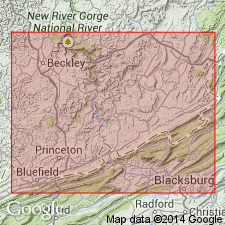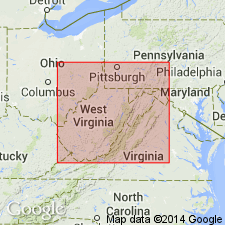
- Usage in publication:
-
- Taggard shale [member], limestone [member]
- Modifications:
-
- Named
- Dominant lithology:
-
- Shale
- Limestone
- AAPG geologic province:
-
- Appalachian basin
Summary:
Named the Taggard shale [member] and Taggard limestone [member] of the Greenbrier limestone in southeastern WV and southwestern VA for Taggard Branch on Indian Creek, Monroe Co., WV. The Taggard consists of 5 to 20 feet of red and sandy shale in the lower part, 5 to 16 feet of white, soft, pure, oolitic limestone in the middle, and 0 to 15 feet of red shale in the upper part. Overlies the Pickaway limestone [member] and underlies the Patton limestone [member] both of the Greenbrier limestone. Unit can be traced northeastward to Pocahontas Co. but does not appear to be present in Mercer Co., WV.
Source: GNU records (USGS DDS-6; Reston GNULEX).

- Usage in publication:
-
- Taggard Formation
- Modifications:
-
- Revised
- AAPG geologic province:
-
- Appalachian basin
Summary:
Revised the Taggard as the Taggard Formation of the Greenbrier Limestone in WV. On correlation chart it overlies the Denmar Formation and underlies the Pickaway Limestone.
Source: GNU records (USGS DDS-6; Reston GNULEX).
For more information, please contact Nancy Stamm, Geologic Names Committee Secretary.
Asterisk (*) indicates published by U.S. Geological Survey authors.
"No current usage" (†) implies that a name has been abandoned or has fallen into disuse. Former usage and, if known, replacement name given in parentheses ( ).
Slash (/) indicates name conflicts with nomenclatural guidelines (CSN, 1933; ACSN, 1961, 1970; NACSN, 1983, 2005, 2021). May be explained within brackets ([ ]).

